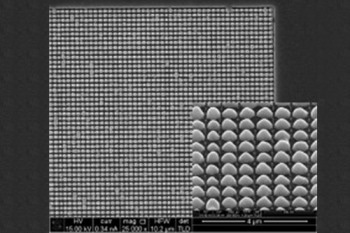Jun 16 2016
A team of researchers from the Universities of Exeter and Bristol are on the verge of creating a new generation of solar cells that are highly efficient and cost-effective.
 Focused ion beam fabricated trilayer metasurface within inset showing rounded features in the upper 2D gold square periodic surface
Focused ion beam fabricated trilayer metasurface within inset showing rounded features in the upper 2D gold square periodic surface
The structure is considered to be one of the world’s very first examples of a tri-layer metasurface absorber utilizing a carbon interlayer.
The innovative system was built by Chenglong Wang a PhD student in Professor Martin Cryan's research group. It utilizes amorphous carbon as an inter-layer existing between thin gold films with the upper film designed with a 2D periodic array by utilizing focused ion beam etching.
The trilayer gold-carbon-gold metasurface absorbs light passing across the solar spectrum, but reduces emission of thermal radiation from the structure. Utilization of gold as part of the research is considered to be a primary step towards a high temperature metasurface, allowing gold to be substituted by many other refractory metals like chrome or tungsten.
The researchers plan to use the cell for solar thermal energy applications. This cell is capable of reaching higher temperatures than that of simple black surfaces, because it has the potential to reduce thermal radiation emission.
The metasurface was produced as part of a joint project work headed by Dr Neil Fox, between Bristol's Department of Electrical and Electronic Engineering and Schools of Physics and Chemistry. This project aims at developing diamond-based solar thermionic devices using sunlight to obtain surfaces that are adequately hot to directly release electrons into a vacuum. Collecting these electrons at a cooled anode results in the production of electrical energy with maximum efficiencies that are estimated to be much higher that what is obtained by using the standard silicon solar cells.
Integrating diamond within metasurfaces is very challenging, and this paper is a first step in that direction using amorphous carbon. The next stage is to carry out high temperature testing on the structures and to attempt to reach the ~700 degrees celsius required to obtain efficient thermionic emission.
Martin Cryan, Professor of Applied Electromagnetics and Photonics in the Department of Electrical and Electronic Engineering
The Bristol team has been working together with Professor Tapas Mallick from the University of Exeter to produce low-cost solar concentrator systems.